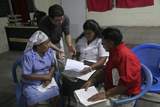ENLACE’s approach is an intuitive, fluid, and dynamic process. It is a process that is adapted to every church and community’s unique history, vision, resources and opportunities. The process is fluid and dynamic because each stage builds from and contributes to one another. It is a general framework more than a rigid methodology.
The six general steps of our approach are as follows: 
alfredo vargas working with leaders of the good samaritan church
· Discovering your church. In the first stage ENLACE helps the church to discover who they are as a congregation. During this stage the church leaders identify attitudes that might impede them from reaching out to their community. They evaluate their current mission and vision statement and organizational structure. They also begin to appreciate the skills and capacities of their leadership and identify resources available in their congregation. Although this stage continues throughout the entire process as a church learn s more about itself and as new members join the church, the initial stage usually lasts between 3 to 6 months.
· Organizing to serve. The second stage involves aligning a church’s resources with their mission and vision. In this stage the church begins to identify and train servant leaders to connect to their community. In some cases a committee or a set of teams is organized to lead the community transformation process. This stage can last from 3 to 6 months.
· Listening to your community. In the third stage church leaders begin to connect to and understand their community. The church leaders will do a series of activities to develop a community profile. These activities include interviewing formal and informal leaders, meeting with local organizations, and conducting one-on-one informal and formal interviews. Other activities in which leaders are encouraged to participate include walking through their community at different times and days of the week, hanging out at favorite community places, and participating in community activities such as meetings, fairs, or parties. The central emphasis of this stage is for the church to begin to develop relationships with community leaders and organizations and begin to serve together. This stage ranges from 6 to 12 months.
· Partnering effectively with your community . The focus of the fourth stage is to create a common vision for the community and develop the leadership and technical skills required to design and manage appropriate initiatives. This stage involves training church and community leaders to identify, design, manage and evaluate sustainable initiatives. It is also during this stage that we train leaders to mobilize local resources to implement the initiative. The final product of this stage is an equipped leadership team and organizational structure that will manage existing initiatives and identify new ones. This stage ranges from 3 to 7 years.
· Incarnating the mission of the church. The emphasis of this stage is to institutionalize the mission of the church in the whole body. It is during this stage that the leadership of the church is encouraged to communicate and celebrate what they are doing with the congregation . The church leadership identifies and trains new leaders, develops new ways of communicating their mission, vision and activities, and hosts church and community events to celebrate transformation. This stage begins shortly after they have started the partnering stage and continues throughout the life of the church.
· Replicating the model. In this final stage, church leaders train and equip other local and regional churches to transform their communities. It is during this stage that ENLACE provides church leaders with the materials and methodology to replicate the process. This stage ranges from 3 to 5 years.
CLICK HERE TO READ THE COMPLETE SERIES.
WE WELCOME YOUR COMMENTS AND QUESTIONS.



